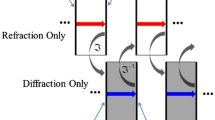Abstract
This technical note presents a technique for estabalshing the boundary retardation with respect to the observed finges. Thus, the available data are increased and, thereby, improve the accuracy of determining fringe spacing near boundaries and, in particular, in thin models. The technique is applicable to scattered-light polariscopes utilizing a quarter-wave plate to circularize the entering polarized light.
Similar content being viewed by others
References
McKinney, J. M. andSwinson, W. F., “Location of Maximum Secondary Principal Axis in Scattered-Light Photoelasticity,”Proc. Fourth Southeastern Conf. for Theo. and Appl. Mech., Pergamon Press, New York (1970).
Author information
Authors and Affiliations
Rights and permissions
About this article
Cite this article
Aderholdt, R.W., Swinson, W.F. Establishing the boundary retardation with respect to the observed fringes in scattered-light photoelasticity. Experimental Mechanics 11, 521–523 (1971). https://doi.org/10.1007/BF02327692
Received:
Revised:
Issue Date:
DOI: https://doi.org/10.1007/BF02327692




